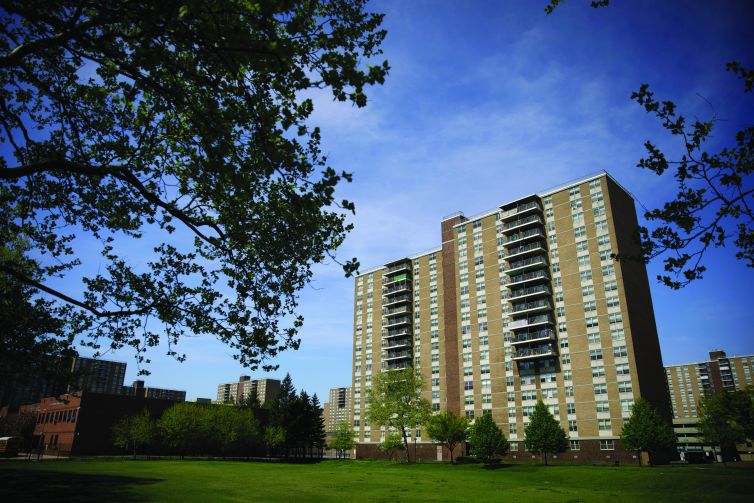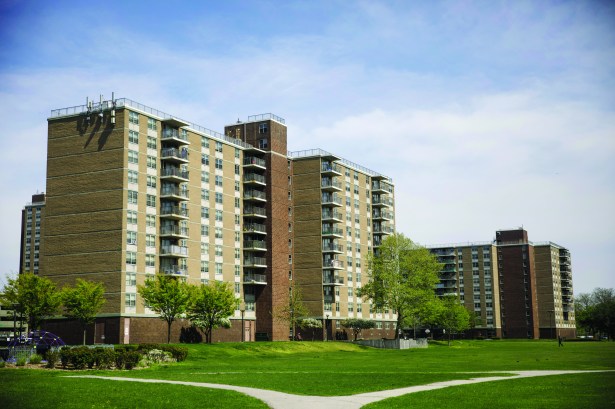Anatomy of a Deal: The $900M Starrett City Trade
Getting into the nitty-gritty of the trade of the largest federally subsidized housing complex in the country.
By Mack Burke June 6, 2018 10:15 am
reprints
The contracted sale of Starrett City in the fall of 2017 was a “get the band together again” moment for some of the players from another New York City megadeal a few years earlier.
Starrett City sits on 145 acres. It comprises 46 buildings and 5,881 affordable apartments in the East New York neighborhood of Brooklyn. And, it has its own power plant and ZIP code. Built in 1974, the multifamily colossus was finally ready to be sold after 43 years; it just needed the right amount of gusto. Along came Brooksville Company and Boston-based Rockpoint Group, ready to pony up more than $900 million.
In order to pull off the long-delayed trade, the deal would require the handiwork of Cushman & Wakefield (CWK) broker Douglas Harmon and Brooksville Company Founder Andrew MacArthur, who both worked together to navigate the political weeds of Stuyvesant Town-Peter Cooper Village in 2015, leading to its historic $5.44 billion sale (Harmon was at Eastdil Secured at the time). MacArthur was an executive at CWCapital Asset Management at the time and helped service Stuy-Town and led its subsequent foreclosure, stabilization and sale.
Harmon was brought in by Starrett City Associates—a group of hundreds of investors led by Carol Deane, widow of the late real estate mogul Disque Deane, who built Starrett—in the first quarter of 2017 to find a palatable, sellable solution.
The move came after decades of political football with federal and state housing officials and local representatives fighting with potential buyers, who officials believed weren’t interested in maintaining the site’s affordability status.
Why were these deals able to close in 2015 and in 2017 and not in 2007, when a proposed $1.3 billion deal for Clipper Equity Founder and CEO David Bistricer to purchase Starrett fell through? The market was different. Take a look at the playbook.
In 2006, the number of new condo and co-op units that were approved by the New York State Attorney General’s office eclipsed 25,000, reaching their peak. “In 2006 and 2007 both Peter Cooper-Stuy Town and Starrett City were viewed by global investors as the holy grails of large multifamily opportunities,” Harmon said. “A decade or so ago the market was ripe with speculation and an overall shorter term investment horizon or outlook than exists today.”
“In the multifamily space, converting properties to condos or co-ops was also in vogue and both these properties easily attracted risk capital throughout the capital stack,” Harmon added. “During the last cycle—in 2007—aggressive debt was more prevalent, interest rates were higher, and other people’s money was a weapon easily deployed in the New York, large trophy real estate arena. Deals were growing larger in size and pricing was more elastic up until the credit crisis.”
Indeed, the number of units that got the green light in 2017 was just 8,358. Banks have since been much more disciplined in underwriting loans over the past decade, due in large part to regulatory restrictions enacted after the financial crisis. When you consider federal regulations paired with Mayor Bill de Blasio’s plan to be a champion of affordable housing and you have a perfect storm of government intervention.
“Unlike a traditional asset in a less-regulated market, where you have a buyer and a seller and you come to a price and that’s the value, [with Starrett] you had the buyer and the seller and an interested party, which is a combination of the tenants and the government, who have a seat at the table one way or another,” sources with knowledge of the deal told Commercial Observer. “You’re going to have to do it in a way that is consistent with their objectives to truly find your value.”
In May 2014, de Blasio announced a 10-year, $41 billion plan—called “Housing New York: A Five-Borough, 10-Year Plan”—to preserve or construct 200,000 units of affordable housing in the city, which a project like Starrett City would be essential to.
“How these two deals would be owned, capitalized and managed for the future would be a chess game that took more in-depth and strategic thinking rather than the more simple checkers game that was played in 2006 and 2007,” Harmon said. “A buyer of these deals would need to bet much more of their own capital long term than they would have a decade or so ago.”
Harmon said a deal such as Starrett, with its history of government and local scrutiny—after all, it is the largest federally subsidized housing development in the country—it needed to be done transparently, but quietly, to minimize news headlines and community outcry.
The plan was to not stubbornly over-leverage the asset, which would force the sponsor to fight to increase rents in order to generate cash flow. That would mean trying to push tenants out, which was a strategy that backfired with pre-2015 iterations of the Stuy-Town saga and was also a worry regulators had with the proposed $1.3 billion sale of Starrett City in 2007.
“Starrett [City] Associates had been stuck for 10 additional years beyond when they thought they would be out of the property, so they had lived the reality of it,” a source with knowledge of the deal told CO. “Someone might’ve been able to come up with a $1.3 billion spreadsheet value in 2007 for the asset, but if you’re not able to get your hands on the money, it doesn’t matter.”
Starrett needed to be approached in a way that would protect the tenants—effectively appeasing the loudest politicians and critics—and stabilize the asset for the long term. A similar strategy allowed the trade of Stuy-Town to move forward in 2015.
The property needed a buyer who not only knew how to execute the playbook but who could hold the asset and had the wherewithal to shoulder the financial obligation and improve the property’s infrastructure—these were critical requirements presented by the New York State Department of Homes and Community Renewal (DHCR) in the early stages of negotiation, according to an official at DHCR who was close to the negotiations.
“From the outset, we made clear to the parties involved in the sale of Starrett City that we would not let it move forward unless three goals were achieved: investing in [improving] the property, capping rent increases and extending affordability. The approximately 15,000 residents who live there now and the next generation have the security of knowing they will continue to have safe, affordable homes,” DHCR Commissioner RuthAnne Visnauskas told CO via email.
For Stuy-Town in 2015, the perfect capital partner was Blackstone. In 2017, it was the combination of Brooksville and Rockpoint. Officials at Rockpoint Group declined to comment for this story.
“With Starrett City, it’s got the affordable spectrum from Section 8 to Mitchell Lama and every kind of affordable complexity and stigma attached to it,” Harmon said. “We were able to find an institutional group who could appreciate what it was and not change the heart of the asset by doing anything that was detrimental to the community.”

In early May 2018, Brooksville and Rockpoint officially received approval from federal and state housing officials to purchase the embattled 44-year-old mega-housing complex Starrett City for $905 million from Starrett City Associates. The buyers were able to complete the purchase with a 10-year, $502 million Fannie Mae loan package from Wells Fargo Multifamily Capital that included a $470 million A-note and a $31.5 million B-note. Rockpoint provided the remaining equity.
MacArthur had worked with Rockpoint on a previous project at 63-67 Wall Street.
“Rockpoint combined long-term stable capital with one of the best management teams in the market,” MacArthur said. “Since they were already partners of ours on another investment, I knew firsthand that they were both exceptionally experienced and operated with a high degree of integrity. These were critical factors in choosing a partner for an opportunity like this because you know going in that it will be a long haul and that you will need to work through unanticipated issues together.”
Similar to the Stuy-Town narrative, federal, state and local political officials as well as New York City residents and community organizers focused on fighting to maintain Starrett’s U.S. Department of Housing and Urban Development (HUD) Section 8 and New York State’s Mitchell-Lama affordable-housing statuses and resident protections while demanding transparency throughout the entire deal process.
“I think coming out of the Stuy-Town experience, we had earned some good will from various regulatory agencies and other stakeholders,” MacArthur said. “We took a highly distressed situation in one of the city’s most important properties and were able to stabilize it and ultimately sell the property in a way that fulfilled our obligations to our investors while also being generally aligned with the city’s policy priorities and the community’s goals as it related to the preservation of long-term affordability. It wasn’t always easy… but in the end, we had a positive outcome for virtually all stakeholders.”
Brooksville had its capital partner, but the next step was bridging the gap with regulators. “We were able to anticipate much of what the government was going to want,” MacArthur said. One caveat was that while the property’s Section 8 status was set to expire in 2029, it’d still be encumbered by its Mitchell-Lama protections for another decade.
The arrangers also didn’t want to approach HUD for discretionary approval, knowing President Donald Trump had an interest in the selling party, sources said. What the arrangers did was use a piece of what’s called a HUD Interest Reduction Payment (IRP) loan—which was actually the $31.5 million B-note supplied by Wells Fargo in the new financing, sources said—that was already a part of the original subsidy package on the property in order to trigger a HUD provision that automatically extended the Section 8 HAP (Housing Assisted Payments) contract by 20 years.
The effect of a HUD IRP loan is to reduce the monthly debt service to what it would be had it been at a 1 percent interest rate and at a 40-year term, with no Federal Housing Administration mortgage insurance premium included. This helps facilitate affordable rent levels.
To add to the hoopla, HUD Secretary Ben Carson’s office was mid-transition when the sale was being examined, creating additional challenges, sources said. Nonetheless, HUD’s history and experience with the property proved to fuel a sufficient amount of scrutiny. Calls to HUD’s press office to discuss the transaction were not returned.
“If anything, we received significantly more scrutiny in the HUD process,” MacArthur told Bloomberg. “Civil servants inside of HUD were very focused and understood the type of scrutiny this transaction would receive.”
Onward and upward. In September 2017, around the time of the sale agreement, Sen. Chuck Schumer, who played a role in blocking a previous potential trade of the property in 2007, said in a statement that he’d be “watching [Starrett] like a hawk to make sure any new owner follows every iota of that [sale] agreement.”
Rep. Hakeem Jeffries, who represents New York’s 8th District, which includes East New York and the residents of Starrett City, said at the time of the contract, “Starrett City is home to thousands of working families in Brooklyn…The proposed sale should be rejected unless the residents are guaranteed that the largest federally subsidized development in the country will remain a safe, clean and affordable place to live. We will not let the gentrification steamroller run over East New York.” A representative from Jeffries’ Washington, D.C., office did not return calls for comment.
The buyers set out to appeal to the community and its representatives, meeting with residents 15 or so times to explain the process and their intentions. In order to achieve the approvals for the purchase, the joint venture buyers pledged to deploy around $140 million in capital improvements, which include rebuilding the Consolidated Edison power plant on the site. The sale agreement also extended the complex’s Section 8 status for an additional 20 years, through 2049, and its Mitchell-Lama protections for another 15 years, through 2054.
“From the start, we knew we would need to work very closely with HUD and DHCR and elected officials to get this done in a way that all stakeholders could support. Everyone had to be committed to a transparent process,” MacArthur said. “That involved a lot of upfront communication with tenants and community leaders to make sure everyone understood that we had a common goal of maintaining, and even extending, affordability.”
What followed the sale was a lawsuit filed by Starrett Associates’ minority owners to block the sale over issues related to the final sale price, which they claimed was below market rate.
Other conflicts included challenges from federal and state officials about Trump’s 4 percent stake in the property—inherited from his father, Fred Trump—as he stood to pocket millions from the trade.
Trump received over $5 million in income from the complex as an investor, according to information in a financial disclosure document submitted to the U.S. Office of Government Ethics in June 2017. The New York Times reported in September 2017 that executives with knowledge of the details of the transaction said anonymously that it was possible Trump could reel in upwards of $14 million in proceeds after the Starrett partners paid off their mortgage, transfer taxes and other transaction costs.
The final chapter in the sale was when a Supreme Court judge struck down the last of the legal challenges in January, and the sale finally went through.
“[Both Stuy Town and Starrett] were highly unusual, having to solve for every different stakeholder from the community and tenants to the mayor, to the governor and even in the case of Starrett, the president of the United States,” Harmon said. “The fairy tale ending of both of these deals was a byproduct of many things; but the chosen bespoke process and buyer search with institutional financial firepower, credibility and experience in tow was critical this time around because failure would have rendered both projects almost illiquid.”


